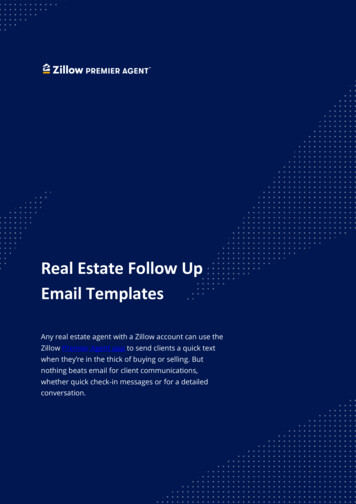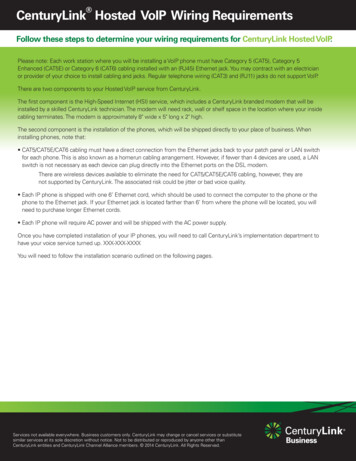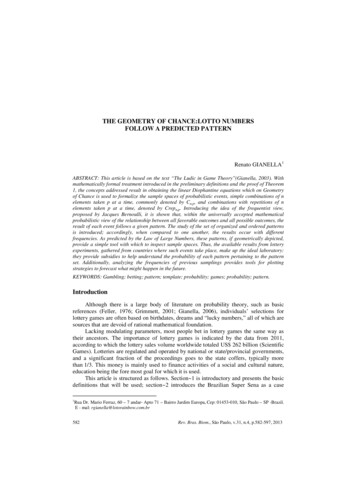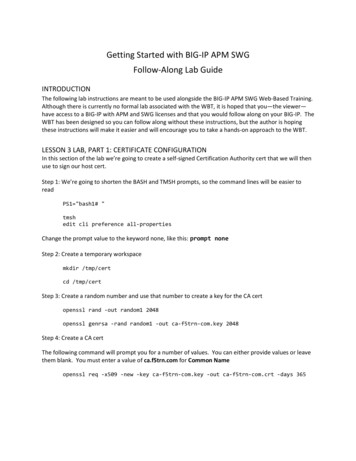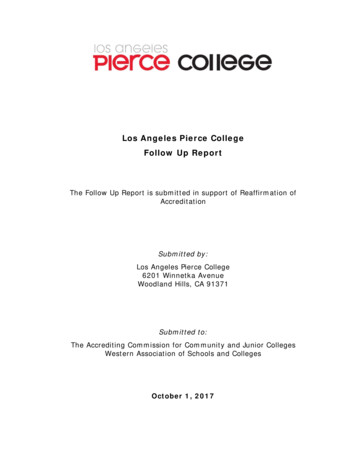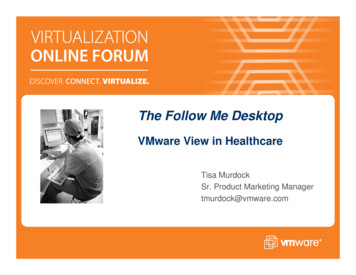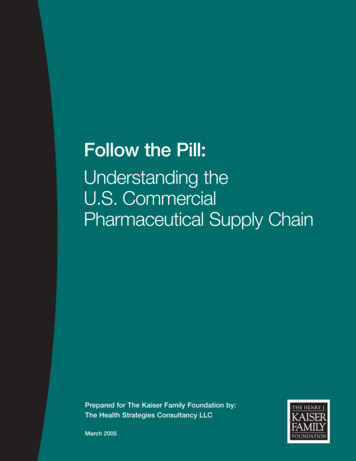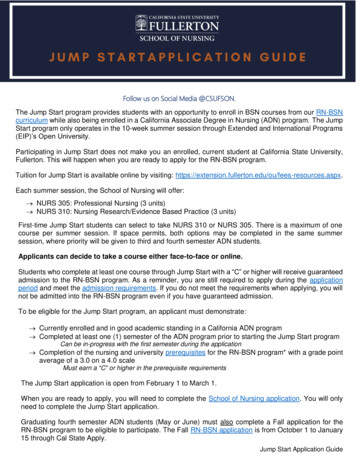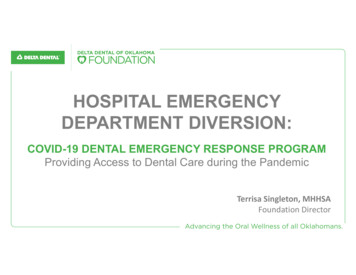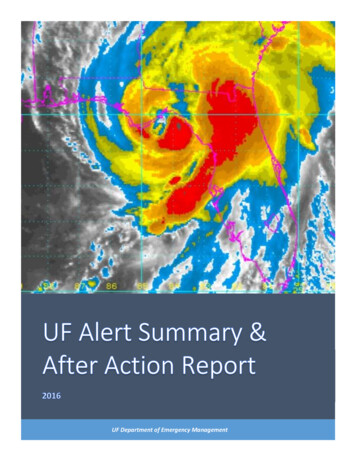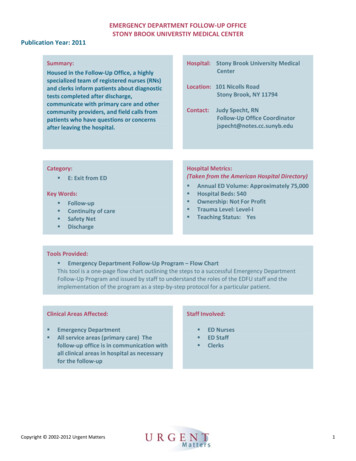
Transcription
EMERGENCY DEPARTMENT FOLLOW‐UP OFFICESTONY BROOK UNIVERSTIY MEDICAL CENTERPublication Year: 2011Summary:Housed in the Follow‐Up Office, a highlyspecialized team of registered nurses (RNs)and clerks inform patients about diagnostictests completed after discharge,communicate with primary care and othercommunity providers, and field calls frompatients who have questions or concernsafter leaving the hospital.Hospital: Stony Brook University MedicalCenterCategory: E: Exit from EDHospital Metrics:(Taken from the American Hospital Directory) Annual ED Volume: Approximately 75,000 Hospital Beds: 540 Ownership: Not For Profit Trauma Level: Level‐I Teaching Status: YesKey Words: Follow‐up Continuity of care Safety Net DischargeLocation: 101 Nicolls RoadStony Brook, NY 11794Contact:Judy Specht, RNFollow‐Up Office Coordinatorjspecht@notes.cc.sunyb.eduTools Provided: Emergency Department Follow‐Up Program – Flow ChartThis tool is a one‐page flow chart outlining the steps to a successful Emergency DepartmentFollow‐Up Program and issued by staff to understand the roles of the EDFU staff and theimplementation of the program as a step‐by‐step protocol for a particular patient.Clinical Areas Affected: Emergency DepartmentAll service areas (primary care) Thefollow‐up office is in communication withall clinical areas in hospital as necessaryfor the follow‐upCopyright 2002‐2012 Urgent MattersStaff Involved: ED NursesED StaffClerks1
InnovationHoused in the Follow‐Up Office, a highly specialized team of registered nurses (RNs) and clerks inform patients aboutdiagnostic tests completed after discharge, communicate with primary care and other community providers, and fieldcalls from patients who have questions or concerns after leaving the hospital.ResultsThe walk out rate has significantly decreased to a 1% rate by tracking the reason for a patient leaving without being seenand addressing those issues.Since the opening of the follow‐up office they now have a far larger caseload — resulting from a stark uptick in EDvolume. All ED charts are now scanned as the patient is discharged and all forms can be immediately accessed via EDScanchart, eliminating the need for staff to search for a paper chart.The Follow‐Up Office has been well received by community physicians, who have been overwhelmingly positive in polls,as well as by patients, who express relief that the process for sharing information is simple and requires no cost oreffort. Continuity of care is promoted. ED staff experienced relief from the numerous phone requests for guidance,information, clinical concerns, and requests to have information faxed to primary care physicians In addition, a secondcheck may reduce the potential for liability.From the Experts“The follow‐up office is a safety net that diverts all aftercare issues away from the ED staff.” Judy Specht, RN, Follow‐UpCoordinator, Stony Brook University Medical CenterInnovation ImplementationED patients are most often unknown to staff, and yet the physician is expected to examine, diagnose and treatpotentially serious conditions and injuries in a timely manner without the ability to determine if the treatment waseffective or the diagnosis correct.Patient satisfaction within the ED is directly related to wait time and the speed and ease of discharge, but diagnostictesting performed in the ED often provides results hours or days after the patient has left the facility.After 9/11, the Department of Health began a practice of calling daily to log how many patients are encountered eachday but requiring ED physicians to monitor and report these findings would prevent them from providing essential careto patients.The tasks of the Follow‐Up Office staff fall into one of two categories: calling patients to alert them to medical conditionsidentified by tests and scans and handling in‐coming patient inquiries covering a wide range of issues, from concernsabout wound care to requests for proof of their ED visit to satisfy an employer. The Follow‐Up Office staff cross‐reference the diagnostic results with the patient chart to look for thingsthat may have fallen through the cracks.Often a test ordered to address one symptom will flag another, sometimes more serious, condition. TThe designated team to deal with these calls relieves physicians and other ED clinicians of the burden ofphone calls and paperwork. It also provides a back‐up set of eyes to review the patients’ medical chartsto make sure the ED staff did not fail to record any symptoms or diagnostic results during the visit.RNs review every lab result and radiology report to identify abnormal findings not documented on thechart, in which case the patient must be called at home and informed.Copyright 2002‐2012 Urgent Matters2
Work sheets are created to follow every result to completion, and 50‐60 patient follow‐up calls aremade daily. A progress note is created for the purposes of patient education and becomes part of thepermanent medical record.Cost/Benefit AnalysisThe follow‐up office at Stony Brook began in a trailer outside the hospital nearly 20 years ago, the office now occupiesits own space and has expanded its caseload from roughly 90 to 300 patient chart reviews per day. Staffed by two full‐time registered nurses, two part‐time registered nurses, and three clerks, the Follow‐Up Office is open seven days aweek, 365 days per year, for 10 hours per day. Salaries are paid by the Department of Emergency Medicine, which alsopurchases all supplies and equipment. Staff is the greatest expense, and the requisite equipment is limited to phones,fax machines, computers and space.Advice and Lessons Learned1. Consider the costs and resources involved before launching this type of program2. Use experienced nurses with experience in the ED who are able to address a wide variety of patientconcerns3. Employees, both clerical and professional should have the knowledge and skills regarding patient education4. Staff should have a reassuring phone demeanorTools to Download Emergency Department Follow‐Up Program Flow ChartRelated Resources Urgent Matters E‐Newsletter (Volume 7, Issue 5): Innovations: Scheduling Follow‐up appointments throughthe EDCopyright 2002‐2012 Urgent Matters3
Emergency Department Follow Up ProgramStony Brook University Medical CenterCompleted paper chartis scanned in ED(Scanchart)Paper Charts to EDFollow Up OfficeEDFU staff utilizeScanchart to respond tonumerous calls from patientspharmacies, schools, PMDsemployers, clinics, facilitiesaftercare issuesPaper chartstoEDFUAdmitted patientsChart review by EDFU RN staffto evaluate for trending andmandated reportingDischarged patientsChart review by EDFU RN staffAMA/WalkoutDischarged by ED staffPhone contact patientChart review by EDFU staffto determine need to contactpatient/mandated reportingDocument reason forleaving and need foradditional interventionsAll test results are followed tocompletion/ compared to thedocumented findingsChart to EDFU clerkAll notes and test resultsfaxed to the PMDEDFU clerk faxes ED record,test results to PMDIdentified patients arecontacted, informed andeducated about test results orrecalled to EDChart to Medical recordsChart to Medical RecordsPaper chart to EDFU clerk tofax to PMDChart to Medical Records
Volume 7, Issue 4July/August 2010Mission Critical Moving Outside the Walls of the EDBEST PRACTICES: EMERGENCY DEPARTMENT FOLLOW-UP OFFICEThe emergency department (ED) is most commonly associated with acute illness and traumaticinjury — heart attacks, car accidents, gunshot wounds, even anaphylactic shock — but the realityis that many visits to the ED are triggered by symptoms that stem from grave but undetectedconditions. That, and the transient nature of ED patients, creates special challenges for healthcare.“Due to the nature of the ED, patients are most often unknown to staff, and yet the physician isexpected to examine, diagnose and treat potentially serious conditions and injuries in a timelymanner without the ability to determine if the treatment was effective or the diagnosis correct,”observes Judy Specht, R.N., of Stony Brook University Medical Center in New York. “Patientsatisfaction with the ED is directly related to wait time and the speed and ease of discharge, butdiagnostic testing performed in the ED often provides results hours or days after the patient hasleft the facility. So providing professional aftercare services is essential.”The importance of carefully reviewing and documenting the diagnostics administered to EDpatients is whyStony Brook University Medical Center has a designated team whose sole job is to managecommunications with patients and their providers after they have been discharged from the ED.Housed in the Follow-Up Office, a highly specialized team of RNs and clerks inform patients aboutdiagnostic tests completed after discharge, communicate with primary care and other communityproviders, and field calls from patients who have questions or concerns after leaving the hospital.Established in a trailer outside the hospital nearly 20 years ago, the office now occupies its ownspace and has expanded its caseload from roughly 90 to 300 patient chart reviews per day.Staffed by two full-time registered nurses, two part-time registered nurses, and three clerks, theFollow-Up Office is open seven days a week, 365 days per year, for 10 hours per day. Salariesare paid by the Department of Emergency Medicine, which also purchases all supplies andequipment.Creating A Safety NetSpecht, who runs the Follow-Up Office, characterizes the program as “a safety net that diverts allaftercare issues away from the ED staff.” The tasks of the Follow-Up Office staff fall into one oftwo categories: calling patients to alert them to medical conditions identified by tests and scansand handling in-coming patient inquiries covering a wide range of issues, from concerns aboutwound care to requests for proof of their ED visit to satisfy a employer.Having a designated team to deal with these calls is beneficial for two reasons, Specht says.First, it relieves physicians and other ED clinicians of the burden of phone calls and paperwork.Second, it provides a back-up set of eyes to review the patients’ medical charts to make sure theED staff did not fail to record any symptoms or diagnostic results during the visit. Often, shenotes, a test ordered to address one symptom will flag another, sometimes more serious,condition. The Follow-Up Office staff cross-reference the diagnostic results with the patient chartto look for things that may have fallen through the cracks.Copyright 2002-2010 Urgent Matters1
Volume 7, Issue 4July/August 2010Mission Critical Moving Outside the Walls of the ED“If something’s not written in the chart,” says Specht, “I’m going to assume no one discussed itwith the patient.”For maximum efficiency, the RNs handle specific tasks and delegate others to the clerks. RNsreview every lab result and radiology report to identify abnormal findings not documented on thechart, in which case the patient must be called at home and informed. Work sheets are createdto follow every result to completion, and 50-60 patient follow-up calls are made daily. A progressnote is created for the purposes of patient education and becomes part of the permanent medicalrecord.Communicating with Patients“There is an enormous amount of time spent on patient education when a patient must beinformed of an incidental finding on a CAT scan or a positive culture,” Specht notes, sayingpatients might be told, for example, they have a lung nodule, Lyme Disease, or they are infectedwith an organism resistant to the antibiotic they were given in the ED.If the nurse is unable to contact the patient after two attempts and the finding requires nonurgent intervention, a letter is sent to the home. If the finding requires a treatment that shouldnot be delayed, a letter is sent via UPS. Or, if it is urgent the patient return to the ED and thepatient cannot be contacted by phone, the police are sent to the home.In addition, every patient who walks out prior to discharge, leaves without being seen, or leavesagainst medical advice is contacted to determine why they left and to make sure that they havethe resources that they need.“We are often able to convince patients who remain symptomatic to return,” Specht says. “Iftheir needs are financial, we can provide contact with the financial aid department; if they’resocial, with our clinical social worker. If they have no primary medical doctor or dentist, we canshare clinic numbers with them and may even negotiate an appointment. An effort is made in allcases to determine if safety is an issue. Victims service referrals can be initiated if there is anissue associated with domestic violence. Tracking the reason for a patient leaving without beingseen and addressing those issues has decreased our walkout rate significantly. We now generallyhave only about a 1% rate.”The Follow-Up Office also handles daily and episodic reports to the Department of Health, whichmandates the reporting of events such as animal bites, Lyme Disease, pesticide ingestion, certainburns, sexually transmitted diseases, possible rabies exposures, diagnostic clusters (i.e. foodborne illnesses), and evidence of pandemic viruses.“The DOH calls daily to log how many patients are encountered each day,” a practice that startedafter 9/11, Specht says. “Requiring ED physicians to monitor and report these findings wouldprevent them from providing essential care to patients and thus all reporting has been assumedby our program.”Clerks conduct basic telephone screening, provide non-clinical information to patients, andmaintain records of each chart processed through the office. The bulk of their workload entailsfaxing all ED reports to each patient’s primary care physician. The Follow-Up Office has aCopyright 2002-2010 Urgent Matters2
Volume 7, Issue 4July/August 2010Mission Critical Moving Outside the Walls of the EDcomputerized fax for ED forms and has installed the names and fax numbers of almost all thephysicians in the county. Clerks often have to send information to other counties or states,which then requires a call to the physician’s office to obtain fax numbers. In addition, the testresults are manually faxed, and the office is currently working on a system to allow computerizedfaxing of labs as well.Finally, if the office staff need advice or counsel from a physician to address a patient problem,the main ED attending or pediatric ED attending physicians are available for consultation.According to Specht, the office has changed considerably over time. In addition to a far largercaseload — resulting from a stark uptick in ED volume — all ED charts are now scanned as thepatient is discharged and all forms can be immediately accessed via ED Scanchart, eliminatingthe need for staff to search for a paper chart.Improving the Quality of CareThe Follow-Up Office is now seen as an important source of clinical expertise. All new RN staffmembers must spend a day in the office to learn about different types of concerns patients mayencounter after discharge. In addition, all third-year ED residents spend 10 days in the Follow-UpOffice. During this time, residents actually make some of the patient calls and spend timelistening to concerns.Specht, who has presented the Follow-Up Office on two occasions to the Emergency NursesAssociation Scientific Assembly, has not identified a single comparable program in the country.According to Specht, similar offices do exist in other EDs, however their scope of work andresources is not as comprehensive as theirs.Specht cautions hospitals to consider the costs and resources involved before launching a similarprogram, but she says the requirements are minimal. Staff are the greatest expense, and therequisite equipment is limited to phones, fax machines, computers and space. Specht also says,“it’s critical to use only very experienced nurses with ED experience who are able to address awide variety of patient concerns. Employees, both clerical and professional, need to possessknowledge and skills regarding patient education and must have a reassuring phone demeanor.”Specht says the Follow-Up Office has been well received by community physicians, who havebeen overwhelmingly positive in polls, as well as by patients, who express relief that the processfor sharing information is simple and requires no cost or effort. Continuity of care is promoted.ED staff, she says, “has experienced relief from the numerous phone requests for guidance,information, clinical concerns, and requests to have information faxed to primary care physicians.In addition, ED staff have expressed relief that a second check may reduce the potential forliability.”Finally, notes Specht, “because we are the only department in the medical center that has theability and charge to review every patient contact and all results, there have been manyopportunities to initiate research and system change.”Judy Specht, R.N., Stony Brook University Medical Center, Stony Brook, New YorkCopyright 2002-2010 Urgent Matters3
Volume 7, Issue 4July/August 2010Mission Critical Moving Outside the Walls of the EDCopyright 2002-2010 Urgent Matters4
purchases all supplies and equipment. Staff is the greatest expense, and the requisite equipment is limited to phones, fax machines, computers and space. Advice and Lessons Learned 1. Consider the costs and resources involved before launching this type of program 2.
